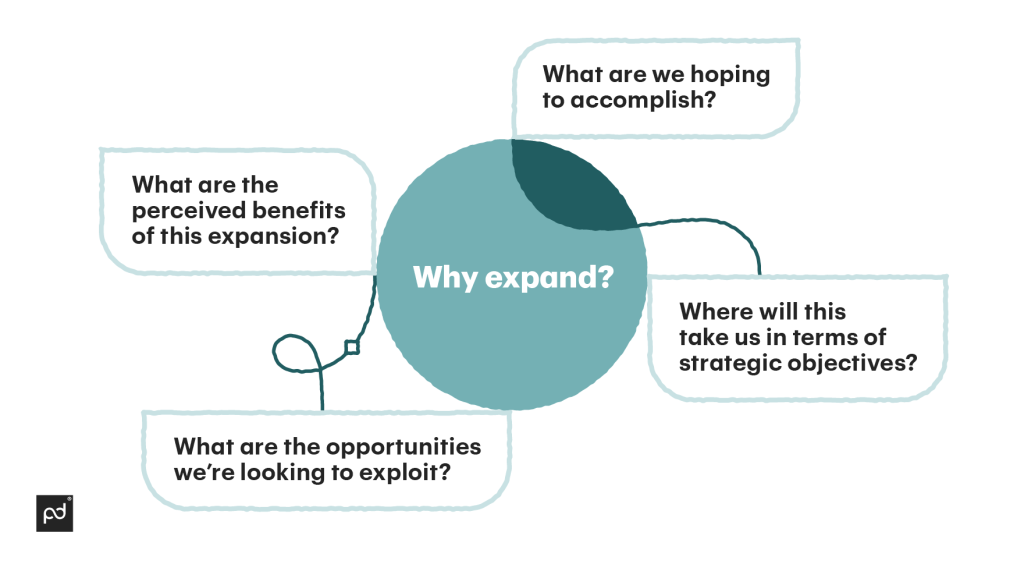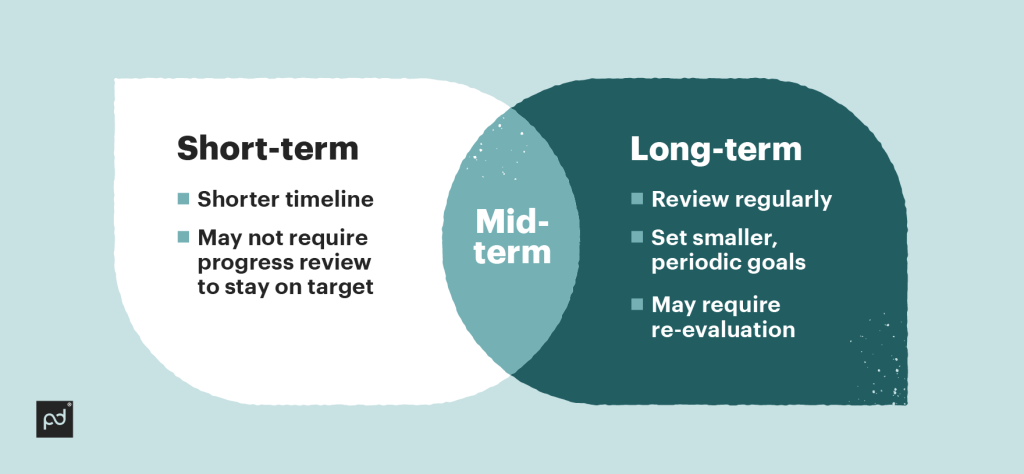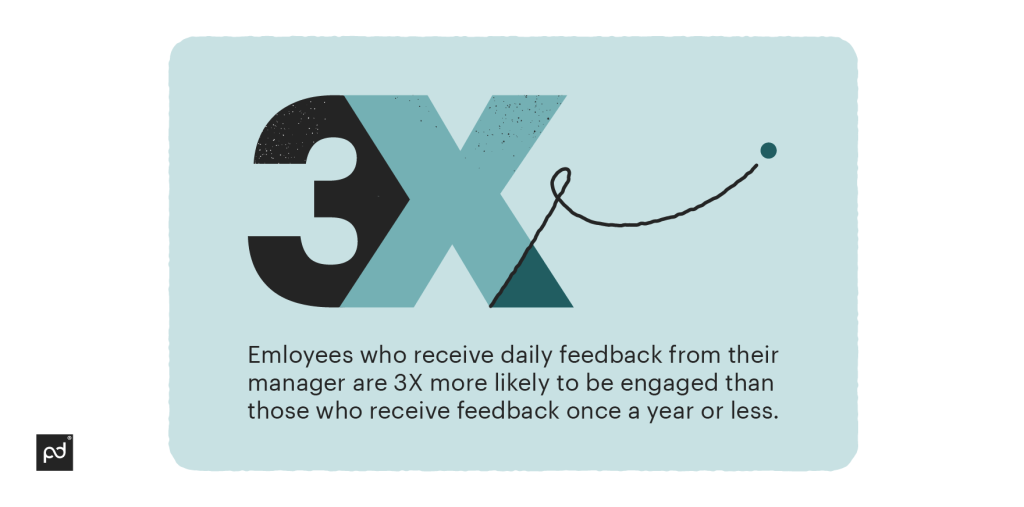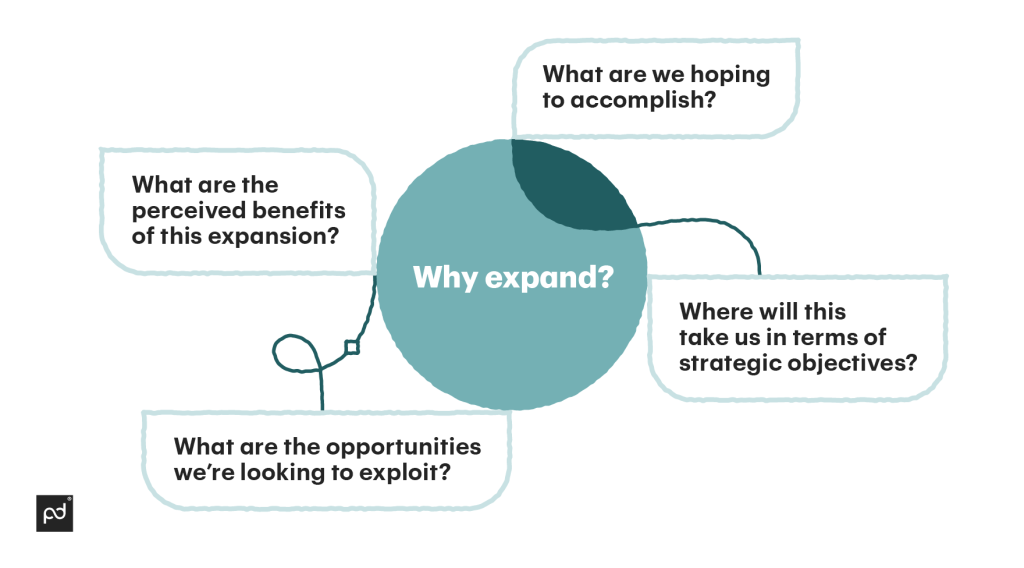Global expansion is one of the most important steps you can take to grow your business.
By going beyond the physical borders of your country, you’ll be able to expand your customer base significantly and conquer new markets.
So if you’re thinking about expanding internationally, now is the time to start building your strategy and a comprehensive plan on how to execute it.
That’s exactly why we wrote this article at PandaDoc: our mission is to help you think strategically about global expansion and its more practical aspects, and also provide a roadmap you can easily follow.
Let’s roll.
Before you start, think about why (and other key questions to ask yourself)
To achieve success, you need to be crystal clear about your motivations, goals, expected results, and the timeframes you set for each objective.
Here are a few key questions that will guide you:
Why is our business looking to expand to new markets?
The first and perhaps most crucial question is “Why are we doing this?”
This might seem like a mundane question with a really apparent answer (“To sell more, obviously!”), but spending time drilling down on all the details and factors that motivate you will help see goals come clearly into focus.
When viewed from different angles, you can reformulate the “why,” narrowing it down to adjacent questions like:

Think about the potential benefits you see now, as well as the specific objectives and the timeframe within which you hope to achieve them.
Once you define “why,” it’ll be much easier to outline what success looks like, and go after it.
Which markets are we targeting?
If your answer is “Well… all of them!”, you need to narrow it down — significantly. Select a few markets that you’d like to focus on.
The criteria might be:
- Geographical or cultural proximity: For example, Canada, if you’re US-based, or New Zealand, if you’re headquartered in Australia
- A shared language: English-speaking countries or Spanish-speaking countries, for example
- A common trade framework: The European Union or the European Economic Area (i.e. the EU + Norway and Iceland)
You might further combine criteria to narrow down your target markets; for example, French-speaking countries in Europe (France, Belgium, Switzerland). You can get help from a professional that does French to English translation, because they can also do English to French, to reach out to these countries since a language platform is essential in localization. Remember, it’s not enough to translate into French, your marketing must be localized for each country.
Or, conversely, you might look into an expansion into multiple territories at once, or into whole geographical areas, such as the EMEA. Just remember, you need the help of a French translation service or even French interpreters for that.
In essence, defining your target markets boils down to using one of the two main expansion strategies:
- Market concentration, where you focus on a few select countries or territories
- Market diversification, where you expand to many new markets at once
To define the right strategy, you need to analyze the local business climate and your capacity to operate there.
Look for markets that:
- Have the right level of maturity for your product or service
- Have favorable conditions for international trade (including tax benefits or a simplified tax system for foreign entities)
- You understand the market culturally, at least to a respectable extent, and in a way you can build the right partnerships to navigate cultural differences
Will our product or service sell there?
Next, you need to look into market fit and local and global competitors to understand whether your product can sell in the country or territory you chose — which means you must do a market analysis.
Ask yourself questions like:
- What is the size of my potential customer base in this target market?
- How can we reach those customers?
- What are the main ways to attract them?
- What are they sensitive to? (Quality, price, features, etc.)
- Do we know what they’re looking for and what they need?
Once you complete this step, you’ll emerge with a solid understanding of your target market. If you see a good market fit, awesome! Time to further assess your opportunities, collect data and start making predictions.
Do we have the right tech stack to help us grow?
When you’re expanding to new territories, it’s crucial to have the right tech stack for scaling your business. This helps you lay the foundation for success and be both scalable and nimble simultaneously.
Let’s look at some of the best tools to help you grow.
For document management
Paperwork can be a drag when expanding internationally, so you need to start thinking of ways to optimize it from the get-go.
For this, a solid contract management system will help you avoid getting bogged down with endless contract modifications that you lose track of, or countless document versions.
Do file names like “Contract_FINALnew.docx” and “Agreement-edited-V04new.docx” sound familiar?
Of course, our view is that the best way to do all this is with PandaDoc, which provides you with a comprehensive solution for all your document management needs and is designed with growing businesses in mind.
There are a number of alternatives, too, such as DocuSign, HelloSign, Proposify, Adobe Sign, Better Proposals, and more.
You can find out how we compare to all of the available options here.
For productivity and team management
Aside from all the ways we’re set up to help you expand globally via streamlined workflows, there are countless apps to help you improve productivity and manage your teams.
Some of the best in class are:
- Google Workspace: Google Workspace is ideal if you want a robust file sharing and management system. It’s particularly useful by enabling real-time synchronous collaboration, allowing all your team members to be able to work together on the same documents simultaneously.
- Microsoft Teams: Microsoft Teams can help you facilitate team communication, file sharing and management. This helps distributed teams work together efficiently across many locations and time zones.
- Slack: Slack helps your team stay in touch, regardless of its size or the locations you’re operating from.
- monday.com: monday.com helps you run your business in a single system and helps teams stay focused on their goals and tasks
- Asana, ClickUp, Airtable: Tools like these three enable you to manage your team’s projects efficiently and work asynchronously on different tasks
To simplify document management across all these applications and help your team collaborate efficiently on key contracts, quotes, and proposals, you can integrate them with your document management system, too.
For customer relationship management
If global expansion is successfully initiated, your customer base will likely experience a phase of rapid growth — and you need to be well-equipped to handle this.
The best way to do this is with the right CRM platform, such as Salesforce, which will enable you to generate more leads, convert them, and manage customer relationships more efficiently.
And the best way to expand its capabilities is to integrate it with a contract management platform, enabling your teams to generate, modify, and sign documents from within your CRM.
You can do this, for example, by stacking Salesforce with PandaDoc, which will help you reduce your teams’ document creation time by 50%, increase the number of documents completed monthly by 87%, and improve close rates by 36%.
Have a plan and stick to it: A step-by-step guide to international expansion
Alright! We’ve talked about the key questions to ask yourself before you start, so now let’s talk about the steps you need to take to plan your expansion strategy.
1. Analyze the market, your competitors, and your ideal customer
We briefly talked about this above, but it’s worth repeating. Thorough market research and competitor analysis are your gateways to success.
Consider market fit, pricing, specific features, and delivery options, at the minimum, and also define your ideal customer in each market.
You definitely need a unified CX strategy across all markets, which also includes a centralized brand vision, but you must combine this with the right personalization strategies to tailor your offering to each market and its specifics.
TikTok is a great example of this.
The company went global with a solid UX and CX strategy and a product where users could easily create and share content, and algorithms that measure users’ attention span, engagement, and interests with a high level of accuracy.
2. Set objectives you can see from space
Next, you need to think about timeframes and define your objectives for:
- The next quarter
- The next year
- The next 3 years
- The next 5 years

To do this, you need to actually use backward goal setting, where you work your way backward from high-level objectives to short-term goals.
For long-term strategies, a timeframe of 3 to 5 years is best. Then, you can break long-term objectives down into short-term goals, such as yearly and quarterly targets.
However, you might not yet have the necessary information to set meaningful long-term goals for your expansion (i.e. for the next 5 years).
In this case, thinking about your goals for the next year is an excellent starting point — it allows you to build a clearly defined vision of where you want to be in the near future, and break things down into smaller chunks.
This will allow you to then create a week-by-week roadmap for the months to come.
Remember to analyze your current position continuously (for example, every quarter) and set your next objectives based on your progress.
3. Analyze your current resources to see what’s missing
When you’re looking to expand internationally, you most likely don’t have everything in place — otherwise, you’d have already expanded, right?
This means that you’ll have to build whatever is lacking.
For example, you might be missing different elements:
- People: Do you have the right people on board to help you manage your international expansion, with the right knowledge and cultural awareness? Disney failed to take into consideration the importance of cultural differences when expanding to France and their HR strategy did not include enough local experts at first — which led to a significant underperformance. Will you be hiring locally? If so, you’ll need to build a comprehensive strategy to hire abroad — and make sure you’re familiar with local employment laws.
- Skills: Does your team have the right skills? Do you have the right local knowledge? Do some people on the team speak the local language? If there are any major expertise gaps before your expansion, you’ll need to sit with your team and evaluate them carefully.
- Tech: Do you have the right hardware and software for the expansion? Is your tech stack the best one for scaling your operations?
- Content: You may need more content either in text, audio, or video. You will need help from a French translator to create the content you need.
4. Fill the gaps
Next, it’s time to plug holes and bridge gaps. To expand internationally, you need to recruit and retain strategically and remember to put the employee experience first.
Engaged employees are the driving force behind your success, especially during phases of rapid growth — this is key to developing your team and well worth the investment.
Upskilling your workforce is closely related to employee engagement, too: If you show your employees that you’re willing to invest in their development, help them upskill, and train them for success, they’ll be more engaged.
And this translates into higher profits and sales, according to research by Gallup: up to 23% and 18%, respectively.

As we covered above, expansion demands you have the right tools, too. It’s essential to build your tech stack before you expand, and that you use tools that are infinitely scalable and can grow with you.
Here are two successful examples: Airbnb’s tech stack includes Amazon CloudFront, Google Analytics, Braintree, Twilio, and MixPanel, while Netflix is rocking it with Oracle, Amazon SES, Airship, Falcor, and GitHub.
A bad tech stack, on the other hand, can have catastrophic consequences: One in two employees say they’d leave a company due to missing or mismatched software.
5. Set up your business for expansion
Next comes the fun part: setting up the actual systems that will allow you to operate in your target markets.
Here are some of the things you might need to do at this stage:
Open bank accounts if necessary
You need to think about all the pesky hidden costs that come with trading with people globally, such as:
Opening an account with a local bank might not be necessary, especially with services such as Stripe or Wise, but doing so may help you mitigate some of the inherent costs.
In addition to those costs, you need to choose the right invoicing software, because the one you’re currently using might not be suitable for an international expansion (but all the better if it is!).
Register with local tax offices
Paying VAT, GST, or other sales taxes is usually necessary once you reach a certain threshold, which is different for each country.
Even if you don’t need to register yet, it makes sense to anticipate any tax liabilities you’ll have further down the line.
In short: think about your taxes before the tax office starts thinking about you.
Register a local company if needed
You don’t always need to register a local DBA — many small businesses simply operate under their original entity.
But if you need to register a local company (for example, if you’ll be opening a local office and hiring locally), allow enough time to complete this step.
Decide how you’ll manage your contracts
Contract management is an essential element of any expansion, local or global, as it’s a critical factor for operational success and helps you lay the foundation for success.
There are many different types of contracts, forms, and proposals you’ll need to manage when expanding internationally, such as:
And as you grow, things get exponentially more complicated. So, how do you tackle this infinite complexity?
By having the right contract management software system in place.
PandaDoc enables you to customize, negotiate, and eSign contracts of any kind, and move with speed and agility through as many negotiation rounds as needed.
Define how to handle customer support
Your customer service strategy needs to be adapted to your projected growth.
How will you handle an increase in requests? Do you have the capacity to handle CS in another language?
If that’s not the case, you’ll need to hire customer service representatives fluent in the language of your target country or countries, too.
Or you can also use automatic translation — many customer queries can be solved this way — but make it clear to customers that you’re using an automated translation service.
Customer relationship management is also crucial, and for this, you need to be equipped with the right CRM software, like Salesforce, Zendesk Sell, or HubSpot CRM.
6. Define how you’ll deliver your products and services
Think about exactly how you’ll deliver your product or service.
This will vary depending on whether you’re shipping physical products halfway across the world or selling a service online.
Delivery of physical products
If you have a physical product, you’ll need to think about things like:
- Local inventory stocks
- Delivery companies
- Shipping and customs fees
- Shipping times
In addition to that, you should consider country-specific regulations: UPS has a comprehensive tool that helps you navigate this when shipping abroad.
Delivery of digital products or services
If you’re selling digital products or services, things are a bit simpler, since you’ll be delivering everything electronically.
Still, you need to think about the best way to do that, so that customers don’t end up confused and request a refund.
Questions to consider include:
- How will your customers access your product or service?
- How will you make sure new customers know how to use your product?
- Will you offer an initial onboarding session?
- How will you schedule it?
- Do you need to set up anything for your customers?
If you’re selling digital downloads, you can either set up a download page or use an add-on platform specifically geared towards downloadable content, such as Shopify Digital Downloads, Sellfy, Podia, or SendOwl, for example.
In all of this, what’s key is communication. Communicate with your customers often and keep them updated on the delivery process, regardless of whether they need to wait for two weeks to receive a physical product or if they’ll simply need to create a new account on your platform to get started.
Think about time zones
When are your customers online? When are they most likely to purchase? Will you be available to assist them at that time, if they need help?
Even if you don’t have a local team in each country you’re serving (and let’s face it, most companies don’t, nor are they expected to), you might need to think about ways to best serve your customers in terms of time zone coverage, and make sure you don’t leave money on the table simply because you’re not available when your Australian customers want to ask you a question.
Hiring offshore employees or contractors might be a way to solve this, or having shift workers.
Another (cheaper) solution would be to use a chatbot for the time when you’re offline, and have a real employee reach out to customers who contacted you via the chatbot.
In addition to that, productivity apps that serve as a central task management hub (such as monday.com, Asana, or ClickUp, for example), help global teams make sure everyone is on the same page by synchronizing all tasks in real-time.
This way, despite time zone differences, you can stay on track and work toward common goals.
7. Analyze results and compare them with your initial objectives
The key to success is to always keep an eye on what you had initially set out to achieve and how this compares with your current reality.
Each month, quarter, and year, look into where you stand and see whether this aligns with what was projected.
Here are some key questions to consider:
- If you were less successful than anticipated, why did this happen? What were the unexpected obstacles you didn’t plan for?
- If things went better than expected, what was the reason for this? Was it a particularly good market fit? Did you manage to seize a new, unexpected opportunity?
- If growth is faster than anticipated, were you able to meet the increased demand?
- If growth is slower, are you able to absorb the costs? And how much longer will you be able to keep up?
For example, if your sales performance in the first 3 months was better than expected, it’s worth looking into the factors that helped.
Did you go above and beyond, capitalizing on a niche market?
Was it due to a gap that competitors failed to fill? A mixture of both? Or did success correlate to a seasonal fluctuation?
If you failed to meet your sales quotas, what was the reason behind this?
Was it something completely unexpected — or something that should have been considered — like an oversight in branding, language, or cultural understanding?
An apt example here is when Home Depot sought to expand into China: the company learned the hard way that the Chinese-buying public did not view home improvement like the DIY American-buying public — culturally, it was more “do it for me” instead of “I’ll fix it myself.”
This attempt at global expansion started shrinking pretty quickly; Home Depot arrived in China in 2006 and was forced to shutter its stores there in 2012.
The other side of the spectrum? Sweden’s IKEA adjusted its brand offerings and strategy for U.S. consumers, leaving a Godzilla-like footprint across the states.
Sometimes, the mistakes are far less nuanced — just blatantly skipping steps can be careless and catastrophic at the same time.
There are numerous IRL examples of complete train wrecks in international branding, the price of not doing your global expansion homework.
8. Assess, adapt, adjust
To succeed, you need to be agile, adapt to the circumstances and results, and adjust your strategy continuously.
If you don’t adapt your plans to what actually happens on the ground, you’ll be hampering your growth.
This is a polite way of saying that, without sufficient operational flexibility and the capacity to change course when that’s needed, you’re doomed.
Make sure you continuously evaluate your progress — at the end of each month and quarter, for example — in order to identify and tackle issues early on and adjust your strategy accordingly.
Global expansion doesn’t have to be a minefield — but you need to plan for it carefully
Thanks to all the modern tech you have at your disposal, international expansion doesn’t have to be as difficult as it once was, or accessible only to the biggest enterprises.
On the contrary, many small businesses conduct their operations globally right from the start or expand internationally soon after.
However, to maximize the opportunities that an expansion offers, you need to plan for it methodically and create a detailed plan like the one we outlined above. You need to get help from a professional like a French interpreter.
This way, you’ll be able to prepare in advance for the challenges you meet and not just run around extinguishing fires and tackling problems as they arise.
Obviously, you also need to be ready to adapt to your actual results and any eventual challenges you face and stay agile and nimble.
PandaDoc is here to help with your international expansion: We’ve got the solutions you need for automated business workflows, streamlined contract management, eSignatures, and much more.
Originally published April 9, 2018, updated August 10, 2022
Disclaimer
PandaDoc is not a law firm, or a substitute for an attorney or law firm. This page is not intended to and does not provide legal advice. Should you have legal questions on the validity of e-signatures or digital signatures and the enforceability thereof, please consult with an attorney or law firm. Use of PandaDocs services are governed by our Terms of Use and Privacy Policy.
Looking For Document Management System?
Call Pursho @ 0731-6725516
Check PURSHO WRYTES Automatic Content Generator
https://wrytes.purshology.com/home
Telegram Group One Must Follow :
For Startups: https://t.me/daily_business_reads




